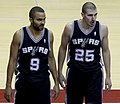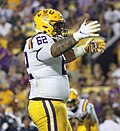South Central United States

The South Central United States or South Central states is a region in the south central portion of the Southern United States. It evolved out of the Old Southwest, which originally was the western portion of the South. The states of Arkansas, Louisiana, Oklahoma, and Texas (which make up what the Census Bureau Division calls West South Central States) are almost always considered the "core" of the region. As part of the East South Central States sub-group of the Census Bureau classification, Alabama, Mississippi, Tennessee and Kentucky are also frequently listed under the heading. At the highest extent, Kansas, and Missouri, may be included by some sources. If defined as only its four core states, the region lies almost exclusively in the Central Time Zone (with El Paso being the only major city to observe Mountain Time). At different times, all of the above states were considered part of the Western United States in American history.
History[]
The history of the South Central states is dominated by the conflict and interaction between three cultural-linguistic groups: the Anglosphere (first Great Britain and then the United States), the Hispanidad (first Spain then Mexico), and the Francophonie (always France).
In the 17th and 18th centuries, Spain and France maneuvered for control of Texas; with the Spanish based in Mexico, and the French in Louisiana. During the War of the Quadruple Alliance hostilities spread to the New World and the French troops from Natchitoches briefly captured the capital of Spanish Texas, Los Adaes, in what is now western Louisiana. The French were not able to wrest control of Texas from Spain, and by the early 19th century sold their North American holdings to the United States in the Louisiana Purchase, which comprised slightly less than half of what is today the South Central United States.
During the Texas Revolution (1835–1836), a rebellion of United States immigrants and Tejanos (Texas Mexicans), put up an armed resistance against the Centralist Republic of Mexico. The Battle of the Alamo was a major turning point during the Texas Revolution. This battle would lead to many Texians deciding to join the Texian Army. Texians would defeat the Mexican Army at the Battle of San Jacinto later on, leading to Texas declaring themselves an independent country in 1836, however Mexico viewed them as a rebellious province. Texas would eventually be admitted as a U.S. state in 1845.
The official West and East South Central states of Texas, Arkansas, Louisiana, Mississippi, Alabama and Tennessee would secede from the Union and join the Confederacy during the Civil War. Kentucky was a border state that remained with the Union. Oklahoma, although Indian Territory at the time, was home to five major Native-American tribes, of which the majority allied themselves with the Confederacy. Oklahoma territory and Indian Territory would merge into the State of Oklahoma, when it became the 46th U.S. state in 1907. All of these states are usually considered to make up a larger part of the American South, both historically and culturally, as well as classified by the U.S. Census Bureau.
Geography[]
The climate varies from the semi-tropical in the Mississippi Delta, South Louisiana, and Southeast Texas, to the dry Chihuahuan desert in West Texas. The southeastern portions include the Appalachian mountains in Alabama and Tennessee and the Piney Woods of East Texas, Louisiana, and southern Arkansas and the Mississippi Delta. A large portion of the northeastern quarter of the region is mountainous, with the Ozark and Ouachita Mountains of Arkansas and eastern Oklahoma. The northwest quarter of the region is dominated by the Great Plains which become progressively drier west of 100° W, forming the North American Llano Estacado. The southwestern portions border the Rio Grande, and are generally drier than other areas of the South Central United States.
Texas is the largest South Central state by both area and population. Texas is still home to over half the region's population. The largest city in the region, Houston, is located in Texas. New Orleans was tied with Oklahoma City in population but, after Hurricane Katrina, the population of the New Orleans metro area declined to approximately 1 million.[1] By 2017, the population of New Orleans had bounced back to almost 1.3 million.[2]
These four states come together in a region known as the Ark-La-Tex region.
Two megaregions exist within this region:
- The Texas Triangle is formed by Interstates 10, 35, and 45 connecting in the shape of a triangle to link the four metropolitan areas of Dallas/Fort Worth, Houston, San Antonio, and Austin.
- The Gulf Coast megaregion is located along the shores of the Gulf of Mexico and primarily along the I-10 corridor centered upon the urban areas of Houston and New Orleans, this megaregion extends into the southeastern region.
| State | 2010 pop. | Land area | Density |
|---|---|---|---|
| Arkansas | 2,915,918 (4th) | 52,068 (3rd) | 51.34 (3rd) |
| Louisiana | 4,533,372 (2nd) | 43,562 (4th) | 102.59 (1st) |
| Oklahoma | 3,751,351 (3rd) | 68,667 (2nd) | 50.25 (4th) |
| Texas | 25,145,561 (1st) | 261,797 (1st) | 79.65 (2nd) |
Major cities[]
| City | City population (2018 est.) | Metro population (2018 est.) | U.S. rank |
|---|---|---|---|
 Houston |
2,325,502 | 6,997,384 | 4 |
 San Antonio |
1,532,233 | 2,518,036 | 7 |
 Dallas |
1,345,047 | 7,233,323 | 9 |
 Austin |
964,254 | 2,168,316 | 11 |
Fort Worth |
895,008 | 7,233,323 | 13 |
 El Paso[a] |
682,669 | 845,553 | 22 |
 Oklahoma City |
649,021 | 1,396,445 | 27 |
 Tulsa |
403,035 | 991,561 | 47 |
 New Orleans |
391,006 | 1,262,888 | 50 |
 Baton Rouge |
221,599 | 830,480 | 99 |
 Little Rock |
197,881 | 738,344 | 121 |
- ^ El Paso is often considered a part of the Southwest Region. In fact, El Paso is the only city on this list that is in Mountain Time Zone instead of the Central Time Zone. El Paso is closer to the Arizona state capital (Phoenix) than it is to the Texas state capital (Austin). El Paso is also closer to the California state line than it is to the Louisiana state line.
Transportation[]
Major commercial airports[13][14][15][16][17][]
- Austin-Bergstrom International Airport
- Bill and Hillary Clinton National Airport (Little Rock)
- Dallas Love Field
- Dallas/Fort Worth International Airport
- El Paso International Airport
- George Bush Intercontinental Airport (Houston)
- Louis Armstrong New Orleans International Airport
- San Antonio International Airport
- Tulsa International Airport
- Will Rogers World Airport (Oklahoma City)
- William P. Hobby Airport (Houston)
Major interstate highways[18][19][20][21][]
 Interstate 2
Interstate 2 Interstate 10
Interstate 10 Interstate 12
Interstate 12 Interstate 14
Interstate 14 Interstate 20
Interstate 20 Interstate 27
Interstate 27 Interstate 30
Interstate 30 Interstate 35
Interstate 35
 Interstate 35E
Interstate 35E Interstate 35W
Interstate 35W
 Interstate 37
Interstate 37 Interstate 40
Interstate 40 Interstate 44
Interstate 44 Interstate 45
Interstate 45 Interstate 49
Interstate 49 Interstate 55
Interstate 55 Interstate 59
Interstate 59 Interstate 69
Interstate 69
 Interstate 69C
Interstate 69C Interstate 69E
Interstate 69E Interstate 69W
Interstate 69W
Sports[]
| Team | Sport | League | Venue | Titles |
|---|---|---|---|---|
 Austin FC |
Soccer | MLS | Q2 Stadium | 0 |
 Dallas Cowboys |
Football | NFL | AT&T Stadium | 5 |
 Dallas Mavericks |
Basketball | NBA | American Airlines Center | 1 |
 Dallas Stars |
Hockey | NHL | American Airlines Center | 1 |
 FC Dallas |
Soccer | MLS | Toyota Stadium | 0 |
 Houston Astros |
Baseball | MLB | Minute Maid Park | 1 |
 Houston Dynamo |
Soccer | MLS | BBVA Stadium | 2 |
 Houston Rockets |
Basketball | NBA | Toyota Center | 2 |
 Houston Texans |
Football | NFL | NRG Stadium | 0 |
 New Orleans Pelicans |
Basketball | NBA | Smoothie King Center | 0 |
 New Orleans Saints |
Football | NFL | Mercedes-Benz Superdome | 1 |
 Oklahoma City Thunder |
Basketball | NBA | Chesapeake Energy Arena | 1[a] |
 San Antonio Spurs |
Basketball | NBA | AT&T Center | 5 |
 Texas Rangers |
Baseball | MLB | Globe Life Field | 0 |
- ^ The Oklahoma City Thunder won their NBA title in 1979 before their relocation to Oklahoma City when the team was known as the Seattle SuperSonics.
| School | Mascot | Conference |
|---|---|---|
 University of Arkansas |
Razorbacks | SEC |
 Baylor University |
Bears | Big 12 |
 Louisiana State University |
Tigers | SEC |
 University of Oklahoma |
Sooners | Big 12 |
 Oklahoma State University |
Cowboys | Big 12 |
 University of Texas |
Longhorns | Big 12 |
 Texas A&M University |
Aggies | SEC |
 Texas Christian University |
Horned Frogs | Big 12 |
 Texas Tech University |
Red Raiders | Big 12 |
References[]
- ^ Zimmermann, Kim Ann. "Hurricane Katrina: Facts, Damage & Aftermath". Live Science. Retrieved March 17, 2019.
- ^ "New Orleans metro area population 2010-2017 | Statistic". Statista. Retrieved March 17, 2019.
- ^ "Texas Demographic Center". demographics.texas.gov. Retrieved March 16, 2020.
- ^ "Demographics and Geography - The official website of Louisiana". www.louisiana.gov. Retrieved March 16, 2020.
- ^ "Oklahoma Cities by Population". www.oklahoma-demographics.com. Retrieved March 16, 2020.
- ^ "Arkansas Cities by Population". www.arkansas-demographics.com. Retrieved March 16, 2020.
- ^ "Louisiana Cities by Population". www.louisiana-demographics.com. Retrieved March 16, 2020.
- ^ "Texas Cities by Population". www.texas-demographics.com. Retrieved March 16, 2020.
- ^ "Distance from El Paso, TX to Phoenix, AZ". check-distance.com. Retrieved December 2, 2018.
- ^ "Distance from El Paso, TX to Austin, TX". check-distance.com. Retrieved December 2, 2018.
- ^ "Distance from El Paso, TX to Los Angeles, CA". check-distance.com. Retrieved December 2, 2018.
- ^ "Distance from El Paso, TX to Orange, TX". check-distance.com. Retrieved December 2, 2018.
- ^ "Aviation and Airports". www.dot.state.tx.us. Retrieved March 16, 2020.
- ^ "Aviation and Aerospace". www.greateroklahomacity.com. Retrieved March 16, 2020.
- ^ "Official Home - Louis Armstrong New Orleans International Airport". Louis Armstrong New Orleans Airport. Retrieved March 16, 2020.
- ^ "Clinton National Airport". Clinton National Airport. Retrieved March 16, 2020.
- ^ "Tulsa International Airport | Tulsa Airports". Tulsa Airport. Retrieved March 16, 2020.
- ^ "Texas Department of Transportation". www.txdot.gov. Retrieved March 16, 2020.
- ^ "LaDOTD". wwwsp.dotd.la.gov. Retrieved March 16, 2020.
- ^ "Arkansas Department of Transportation - ArDOT". www.arkansashighways.com. Retrieved March 16, 2020.
- ^ "Oklahoma Department of Transportation - Oklahoma Department of Transportation". www.ok.gov. Retrieved March 16, 2020.
- ^ "Texas Sports Teams". www.texasoutside.com. Retrieved March 16, 2020.
- ^ "Louisiana Sports Teams". Wright Realtors.com. Retrieved March 16, 2020.
- ^ "Oklahoma City Sports | Professional & Collegiate Sports". www.visitokc.com. Retrieved March 16, 2020.
- ^ "Sports in Louisiana". Louisiana Travel. December 4, 2013. Retrieved March 16, 2020.
- ^ "Texas Sports Teams". Wright Realtors.com. Retrieved March 16, 2020.
- ^ "Arkansas Sports Teams". Wright Realtors.com. Retrieved March 16, 2020.
- ^ "Oklahoma Sports Teams". Wright Realtors.com. Retrieved March 16, 2020.
- South Central United States